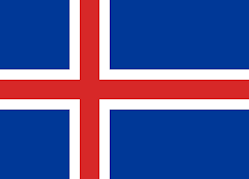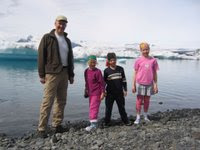On this page you find ideas about what can be done during your stay in Iceland. The focus is on families with kids but many of the activities are of course suitable for everyone.
I hope you will find the information on following pages useful. I wish you a very nice trip and hope you will have a good stay in Iceland.
Family travel in Iceland
Interesting places and things to do in Iceland. Main focus is on families with kids but many good ideas for everyone.
Welcome!
Map of Iceland

Here is a map of Iceland showing the areas on the following pages. It is divided into five parts: Reykjavik and surroundings as one part and then south-west, north-west, north-east and south-east part of the country. The 'Highland' is in the middle of the country.
Good to know
- The icelandic currency is icelandic krona. See currency converter.
- It is OK to drink the tab-water directly from the tab.
- There are many hot spots and internet-cafés in Iceland so it is rather easy to get on the Internet.
- Power supply: Voltage: 220, Frequency: 50 Hz.
Weather and weather forecasting
The weather in Iceland is very changeable. Always be prepared for both sun and rain as you can easily have both during the same day (or even many times the same day). The weather forecast for today and next five days is here.
The average temperature is about 0-10°C (30-50°F) with the coldest months December and January and the warmest month July. This means that on the average it is not very cold in the winter and not hot in the summer eventhough there can come warm days. A warm day in Iceland is a day when the temperature exceeds 15°C.
Still you have to bring sun-protection on your face as the sun can be very strong, especially on the mountains or on the glaciers, eventhough you may not feel it.
You don't see many Icelanders with umbrellas. It is because it is often windy when it is raining so we have given up trying to use them. It is easier to have a nice raincoat handy.
Driving in Iceland
The main roads in Iceland are good and you can get to all the places described on this web by usual car, except for the trips into the Highland. I recommend travelling by bus or special 'mountain cars' there, as there are some rivers you have to cross.
Always remember to drive safely, have the lights on all day (Icelandic law), and every person in the car is required to have the safety-belt on while driving. For better information on driving in Iceland, check this webpage.
Swimming in Iceland
You may see that I recommend a very many swimming-pools. The reason is because my kids love them and when we are travelling they are not happy if they don't go to at least one swimmingpool every day. The best thing is maybe that you can enjoy them no matter of the weather. The pools are heated with hot water from the ground and give excellent movement and/or relaxation for everybody in the family.
General information about Iceland
Iceland is an island of 103.000 square kilometers (39.756 square miles). The country's highest peak, Hvannadalshnjúkur in Vatnajökull, rises 2.110 meters above sea level. Roughly ten percent of the country is covered in glaciers, including Vatnajökull, the largest in Europe.
Because of its location on the Mid-Atlantic Ridge, Iceland is a hotbed of volcanic and geothermal activity, thirty volcanoes have erupted in the past two centuries. Natural hot water supplies the majortity of the population with inexpensive, pollutionfree heating.
People
Iceland's population is about 310.000, about 6% of which are foreign-born. Only 2% of Icelanders live in rural areas, the rest live in urban areas, and the majority, about 75%, live in the capital area of Reykjavik. Each year, more than 400.000 travellers visit the country annually. Life expectancy is one of the highest in the world with about 83 years for women and 80 years for men.
History
It is believed that the first permanent settler in Iceland was Ingolfur Arnarson, a Norwegian Viking who settled in A.D. 874 and named his home Reykjavik ('Smoky bay') after the steam rising from the surrounding countryside.
In 930, Icelanders founded Althingi, which still functions as the legislative body, making it the worlds's oldest parliament. Iceland lost its independence to Norway in 1262 but came under Denmark in 1380. On 17th of June 1944, Iceland became independent of Denmark.
Government
The country is governed by Althingi (parliament), which sits in Reykjavik. The president is elected every four years. The president now is 'Ólafur Ragnar Grímsson'.
Language
The language spoken in Iceland is icelandic, close to that of literature (the Sagas) in the 12th century. Most people can also speak English and Scandinavian. Icelanders maintain a patronymic naming system, meaning that the first name is followed by the name of the father (or mother in rare cases) with the suffix 'son' or 'dóttir' (daughter). For example: Anna Kjartansdóttir is Anna the daughter of Kjartan.
Time Iceland follows Greenwich Mean Time all year round.
Economy
Main export in Iceland is fishing, fisheries products and aluminum. Less than one percent of the land is arable. Iceland produces vegetables, meat, fish and dairy, but imports many foodstuffs. Iceland's currency is the Icelandic Króna (ISK).
Pictures
If not otherwise stated, all pictures on this web and related pages are either taken by the author of this web or from Wikimedia commons with the following commissions:
'Permission is granted to copy, distribute and/or modify this document under the terms of the GNU Free Documentation license, Version 1.2 or any later version published by the Free Software Foundation; with no Invariant Sections, no Front-Cover Texts, and no Back-Cover Texts. A copy of the license is included in the section entitled "GNU Free Documentation license".'
The maps of different parts of Iceland are originated from NASA, see the permission.





